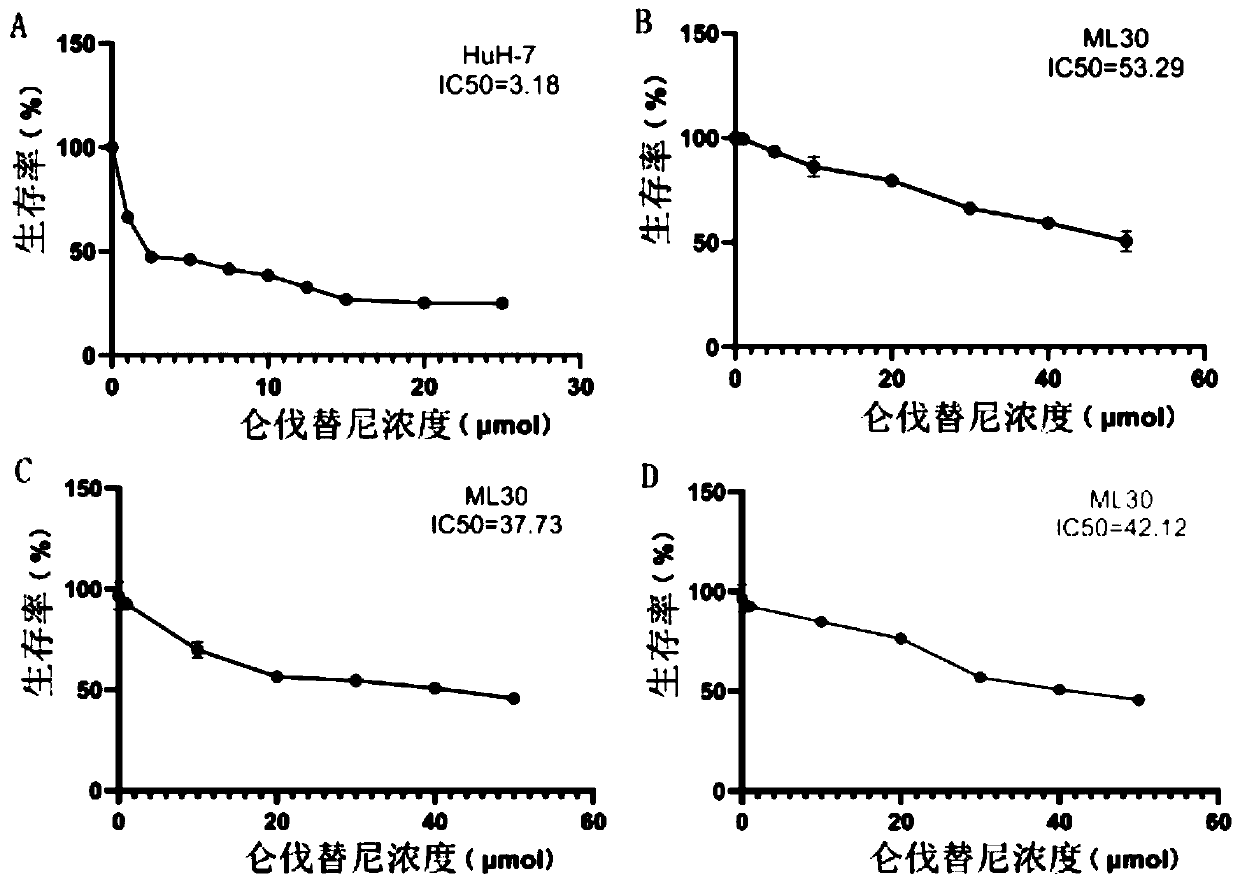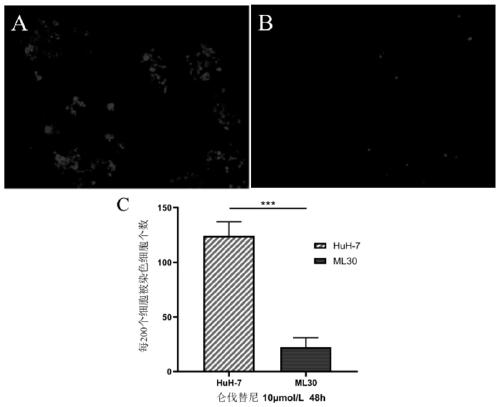Hepatocellular carcinoma lenvatinib drug-resistance cell strain and preparation method and application thereof
A human liver cancer cell line, lenvatinib technology, applied in the field of biomedicine, to achieve the effect of high scientific research and production application value
- Summary
- Abstract
- Description
- Claims
- Application Information
AI Technical Summary
Problems solved by technology
Method used
Image
Examples
Embodiment 1
[0031] Embodiment 1: the preparation of hepatocellular carcinoma lenvatinib drug-resistant cell line
[0032] Get human liver cancer HuH-7 cells with DMEM medium (penicillin 100 units / mL, streptomycin 100 ug / mL) containing 10% fetal bovine serum, at 37 ℃, 5% CO 2 cultured in an incubator; in order to determine the IC50 value of HuH-7 cells, the logarithmic phase cells were planted in a 96-well plate, and the concentration gradients of lenvatinib were set to 0, 1, 2.5, 5, 7.5, 10, 12.5, 15, 20, 25 μmol / L, keep the blank control (only add 100ul DMEM medium containing 10% fetal bovine serum), set 3 duplicate wells for each gradient, treat with lenvatinib for 48 hours, use CCK-8 kit The IC50 value of the cells was measured, and the IC50 value was 3.13 μmol / L, so the initial administration concentration was 3 μmol / L.
[0033] The cells were treated with lenvatinib at a concentration of 3 μmol / L, and the medium was changed every 48 hours. When the cells were full, they were subcult...
Embodiment 2
[0034] Embodiment 2: the IC50 value of liver cancer cell line HuH-7 and the IC50 value of drug-resistant strain ML30
[0035]HuH-7 and ML30 cells in the logarithmic growth phase were digested with 0.5% trypsin (Gibco) and counted, and seeded into 96-well plates at a density of 5000 cells per well in DMEM containing 10% fetal bovine serum for 6 hours After the cells adhered to the wall, the medium was removed, and the medium (DMEM containing 10% fetal bovine serum) containing different concentrations of lenvatinib was added, and the concentration gradient was 0, 1, 10, 20, 30, 40, 50 μmol / L (more than 50 μmol / L lenvatinib can not be dissolved in the culture medium, which will affect the cell state and absorbance measurement), leave a blank control (only add DMEM medium containing 10% fetal bovine serum), set 3 duplicate holes for each concentration, Add 100 μL of medium to each well, place at 37°C, 5% CO 2 Incubate for 48 hours in the incubator.
[0036] Add 10 μL of CCK-8 wo...
Embodiment 3
[0044] Embodiment 3: the cell shape of HuH-7 and ML30 cell under light microscope
[0045] Observe the morphology of live cells with an inverted phase-contrast microscope: HuH-7 cells and ML30 drug-resistant cells in the logarithmic growth phase were taken respectively, and after changing the liquid with PBS (pH=7.2-7.4), the morphology of living cells was observed under an inverted microscope. It can be observed by light microscopy that the size of HuH-7 cells is basically the same. figure 1 A, 1B shown); while ML30 drug-resistant cells vary in size and shape, and more cells fuse into cell colonies (such as figure 1 C, shown in 1D).
PUM
 Login to View More
Login to View More Abstract
Description
Claims
Application Information
 Login to View More
Login to View More - R&D
- Intellectual Property
- Life Sciences
- Materials
- Tech Scout
- Unparalleled Data Quality
- Higher Quality Content
- 60% Fewer Hallucinations
Browse by: Latest US Patents, China's latest patents, Technical Efficacy Thesaurus, Application Domain, Technology Topic, Popular Technical Reports.
© 2025 PatSnap. All rights reserved.Legal|Privacy policy|Modern Slavery Act Transparency Statement|Sitemap|About US| Contact US: help@patsnap.com



